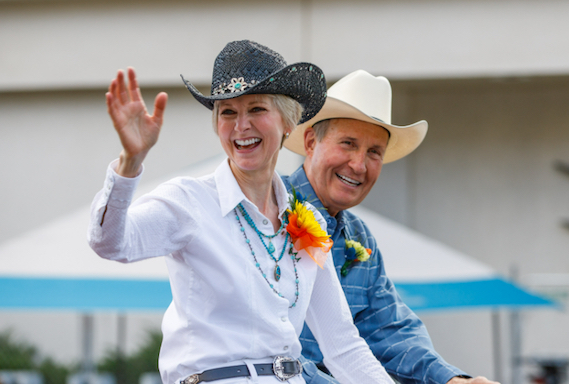Pioneer Day

Pioneer Day is a Utah state holiday celebrated each year on July 24, marking the day Latter-day Saint pioneers entered the Salt Lake Valley and reached their anticipated destination of freedom from religious persecution. It is also known as July 24th or Days of ’47 (also an official non-profit organization that sponsors the Days of ’47 parade and rodeo and other events).[1]
A Brief History of Pioneer Day
The first company of Mormon pioneers, led by Brigham Young, officially entered the Valley of the Great Salt Lake on 24 July 1847. Young’s vanguard pioneer company consisted of 142 men, 3 women, 2 children, and 72 wagons. They traveled 1031 miles before reaching their destination. Some members of the company traveled ahead and arrived in the Salt Lake Valley as early as the July 21, 1847. They immediately began planting crops and establishing homes.[2] By the 24th of July, the entire company had arrived.[3]
On July 28, Brigham Young identified the site for the Salt Lake Temple. He had seen the completed temple many times in vision, and told the Saints that he never looked upon the spot without seeing it there.[4]
Between 1847 and 1868, when the transcontinental railroad neared completion, some 60,000 to 70,000 Latter-day Saints migrated from the United States, Canada, and Europe across the North American Great Plains to Utah and the surrounding regions.
- Mormon pioneers first commemorated this new beginning in 1849. The celebration took place near the spot that Young had recently designated as the site of a future temple, the holiest place in Mormondom. The observance consisted of a procession which led Brigham Young from his home to a bowery on Temple Square to which members of the nearly twenty local LDS congregations had marched earlier that morning behind their respective bishops. Under the bowery, Young presided over a devotional full of both religious reverence and zeal. The celebration ended with a thanksgiving feast for a bountiful harvest and the blessings of a merciful God.[5]
In 1857 several thousand Latter-day Saints gathered in the mountains east of Salt Lake City for the tenth anniversary of the founding of what they considered their western Zion.
During the arrival of Johnston’s Army and the subsequent "federal occupation" of Utah (1857–1858), Pioneer Day was hardly celebrated. “Once the tension had subsided, however, the Mormons renewed celebrating their heritage. The observance of Pioneer Day expanded as the Mormon Culture Region filled the Intermountain West. In the 1860s and 1870s this celebration reflected the self-proclaimed identity of the Latter-day Saints as ‘modern Israel,’ chosen and lead by God to prepare the earth for the millennial reign of Christ.”[6]
- In 1880 the Mormons commemorated the fiftieth anniversary of the church's formal organization. Although this event was remembered at the church's semiannual general conference in April, its principal observance was on 24 July. Tens of thousands of Latter-day Saints in hundreds of communities participated in this jubilee, which was as enthusiastic a celebration as the Mormons had ever created.[7]
During the years of anti-polygamy persecutions, Pioneer Day celebrations were informal. “The 1886 celebration was particularly poignant. The tabernacle on Temple Square was draped, not as usual in colorful bunting, but in black, as for a funeral, and pioneers and church leaders who were in hiding or prison for "unlawful cohabitation" were eulogized for their devotion to the cause of Mormonism.”[8]
- For the 1897 jubilee the Mormons pulled out all the stops. They were celebrating not only the fiftieth anniversary of the arrival of the pioneers, but also the completion of the Salt Lake Temple, Utah statehood, and the virtual end of anti-polygamy persecutions. The spiritual and historical legacy was amply displayed and celebrated, as were the agricultural and industrial products of their efforts in their land of promise. The details and activities of the celebration reinforced Mormonism's security about its past and confidence about its future.[9]
The celebration has grown into one of the largest regional celebrations in the United States. “Pioneer Day has increasingly reflected the cultural and religious heterogeneity of the Mormon Culture Region and of the LDS Church in general. To be sure, pioneering ideals have remained dominant in the celebrations, but the usual themes of "frontier," "homeland," "Zion in the tops of the mountains," and so on have been increasingly applied metaphorically to concerns and ambitions, not exclusively of the Mormons, but of the wider societies in which Latter-day Saints live. In larger cities, especially, the celebration has become more secular, and is seen as a means of coming together and celebrating the society that has been built by Mormons and non-Mormons alike. Though to Mormons the celebration may always bring to mind the pioneers of 1847, to the society as a whole the day is one to celebrate the building of the society by "pioneers" of many eras and backgrounds.”[10]